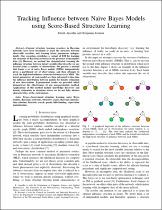 ResearchSpace
ResearchSpace
Tracking influence between naive Bayes models using score-based structure learning
JavaScript is disabled for your browser. Some features of this site may not work without it.
- ResearchSpace
- →
- Research Publications/Outputs
- →
- Conference Publications
- →
- View Item
| dc.contributor.author |
Ajoodha, R

|
|
| dc.contributor.author |
Rosman, Benjamin S

|
|
| dc.date.accessioned | 2017-12-19T12:39:23Z | |
| dc.date.available | 2017-12-19T12:39:23Z | |
| dc.date.issued | 2017-11 | |
| dc.identifier.citation | Ajoodha, R. and Rosman, B.S. 2017. Tracking influence between naive Bayes models using score-based structure learning. 2017 Pattern Recognition Association of South Africa and Robotics and Mechatronics International Conference (PRASA-RobMech), 29 November - 1 December 2017, Central University of Technology, Bloemfontein, Free State, South Africa | en_US |
| dc.identifier.uri | http://www.raillab.org/content/prasa-tracking-influence.pdf | |
| dc.identifier.uri | http://www.rgems.co.za/Downloads/Events/2017_PRASA-RobMech_Program.pdf | |
| dc.identifier.uri | http://hdl.handle.net/10204/9890 | |
| dc.description | Paper presented at the 2017 Pattern Recognition Association of South Africa and Robotics and Mechatronics International Conference (PRASA-RobMech), 29 November - 1 December 2017, Central University of Technology, Bloemfontein, Free State, South Africa. This is the accepted version of the paper. | en_US |
| dc.description.abstract | Current structure learning practices in Bayesian networks have been developed to learn the structure between observable variables and learning latent parameters independently. One exception establishes a variant of EM for learning the structure of Bayesian networks in the presence of incomplete data [1]. However, no method has demonstrated learning the influence structure between latent variables that describe (or are learned from) a number of observations. We present a method that learns a set of naive Bayes models (NBMs) independently given a partitioned set of observations, and then attempts to track the high-level influence structure between every NBM. The latent parameters of each model are then relearned to fine-tune the influence distribution between models for density estimation of new observations. Experimental results are provided which demonstrate the effectiveness of our non-parametric method. Applications of this method include knowledge discovery and density estimation in situations where we do not fully observe characteristics of the environment. | en_US |
| dc.language.iso | en | en_US |
| dc.publisher | IEEE | en_US |
| dc.relation.ispartofseries | Worklist;19960 | |
| dc.subject | Score-based structure learning | en_US |
| dc.subject | Naive Bayes models | en_US |
| dc.subject | Bayesian networks | en_US |
| dc.subject | Structure scores | en_US |
| dc.subject | Bayesian information criterion | en_US |
| dc.subject | Heuristic search | en_US |
| dc.subject | Greedy hill-climbing | en_US |
| dc.subject | Expectation maximisation | en_US |
| dc.subject | Structure learning | en_US |
| dc.subject | Influence networks | en_US |
| dc.title | Tracking influence between naive Bayes models using score-based structure learning | en_US |
| dc.type | Conference Presentation | en_US |
| dc.identifier.apacitation | Ajoodha, R., & Rosman, B. S. (2017). Tracking influence between naive Bayes models using score-based structure learning. IEEE. http://hdl.handle.net/10204/9890 | en_ZA |
| dc.identifier.chicagocitation | Ajoodha, R, and Benjamin S Rosman. "Tracking influence between naive Bayes models using score-based structure learning." (2017): http://hdl.handle.net/10204/9890 | en_ZA |
| dc.identifier.vancouvercitation | Ajoodha R, Rosman BS, Tracking influence between naive Bayes models using score-based structure learning; IEEE; 2017. http://hdl.handle.net/10204/9890 . | en_ZA |
| dc.identifier.ris | TY - Conference Presentation AU - Ajoodha, R AU - Rosman, Benjamin S AB - Current structure learning practices in Bayesian networks have been developed to learn the structure between observable variables and learning latent parameters independently. One exception establishes a variant of EM for learning the structure of Bayesian networks in the presence of incomplete data [1]. However, no method has demonstrated learning the influence structure between latent variables that describe (or are learned from) a number of observations. We present a method that learns a set of naive Bayes models (NBMs) independently given a partitioned set of observations, and then attempts to track the high-level influence structure between every NBM. The latent parameters of each model are then relearned to fine-tune the influence distribution between models for density estimation of new observations. Experimental results are provided which demonstrate the effectiveness of our non-parametric method. Applications of this method include knowledge discovery and density estimation in situations where we do not fully observe characteristics of the environment. DA - 2017-11 DB - ResearchSpace DP - CSIR KW - Score-based structure learning KW - Naive Bayes models KW - Bayesian networks KW - Structure scores KW - Bayesian information criterion KW - Heuristic search KW - Greedy hill-climbing KW - Expectation maximisation KW - Structure learning KW - Influence networks LK - https://researchspace.csir.co.za PY - 2017 T1 - Tracking influence between naive Bayes models using score-based structure learning TI - Tracking influence between naive Bayes models using score-based structure learning UR - http://hdl.handle.net/10204/9890 ER - | en_ZA |





